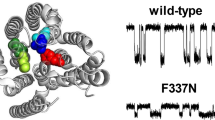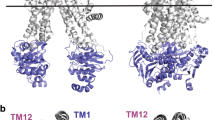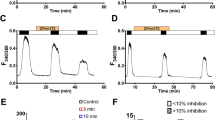Abstract
The cystic fibrosis transmembrane conductance regulator (CFTR) Cl− channel shows only weak selectivity between different small monovalent anions, however, little is known about its ability to discriminate between monovalent and divalent anions. The present study uses patch clamp recording to investigate the interaction between the small divalent anions S2O32− and SO42− and wild-type and pore-mutant forms of human CFTR. Binding of these anions to wild-type CFTR appears weak; at 10 mM, intracellular S2O32− and SO42− blocked <20 and <5% of macroscopic Cl− current respectively, while these same concentrations had no discernible blocking effect when present in the extracellular solution. However, introduction of additional positive charge into the inner vestibule of the pore (in I344K and S1141K mutant channels) drastically strengthened block by intracellular (but not extracellular) S2O32− and SO42−. Block of these mutant channels was highly voltage-dependent; at very negative membrane potentials, apparent binding affinities were ~100 µM for S2O32− and <1 mM for SO42−. Permeability of S2O32− and SO42− was too small to be quantified in wild-type CFTR, but was <1% of Cl− permeability. Mutants that strengthened divalent binding (I344K, S1141K), as well as the selectivity-altering mutant F337A, also showed immeasurably low S2O32− and SO42− permeabilities. Overall CFTR selects well for monovalent over divalent anions, both in terms of binding and permeability. The number or density of fixed positive charges in the pore appears well optimized to disfavour binding of divalent anions, which may be an important facet of the monovalent Cl− permeation mechanism.







Similar content being viewed by others
References
Linsdell, P., & Hanrahan, J. W. (1998). Adenosine triphosphate-dependent asymmetry of anion permeation in the cystic fibrosis transmembrane conductance regulator chloride channel. Journal of General Physiology, 111, 601–614.
McCarty, N. A., & Zhang, Z.-R. (2001). Identification of a region of strong discrimination in the pore of CFTR. American Journal of Physiology, 281, L852–L867.
Smith, S. S., Steinle, E. D., Meyerhoff, M. E., & Dawson, D. C. (1999). Cystic fibrosis transmembrane conductance regulator: physical basis for lyotropic anion selectivity patterns. Journal of General Physiology, 114, 799–817.
Linsdell, P. (2016). Anion conductance selectivity mechanism of the CFTR chloride channel. Biochimica et Biophysica Acta, 1858, 740–747.
Linsdell, P. (2001). Relationship between anion binding and anion permeability revealed by mutagenesis within the cystic fibrosis transmembrane conductance regulator chloride channel pore. Journal of Physiology, 531, 51–66.
Linsdell, P. (2021). On the relationship between anion binding and chloride conductance in the CFTR anion channel. Biochimica et Biophysica Acta, 1863, 183558.
Hille, B. (2001). Ion Channels of Excitable Membranes. 3rd ed. Sunderland, MA: Sinauer Associates.
Linsdell, P. (2017). Architecture and functional properties of the CFTR channel pore. Cellular and Molecular Life Sciences, 74, 67–83.
Linsdell, P., Evagelidis, A., & Hanrahan, J. W. (2000). Molecular determinants of anion selectivity in the cystic fibrosis transmembrane conductance regulator chloride channel pore. Biophysical Journal, 78, 2973–2982.
Negoda, A., El Hiani, Y., Cowley, E. A., & Linsdell, P. (2017). Contribution of a leucine residue in the first transmembrane segment to the selectivity filter region in the CFTR chloride channel. Biochimica et Biophysica Acta, 1859, 1049–1058.
Zhou, J.-J., Li, M.-S., Qi, J., & Linsdell, P. (2010). Regulation of conductance by the number of fixed positive charges in the intracellular vestibule of the CFTR chloride channel pore. Journal of General Physiology, 135, 229–245.
El Hiani, Y., & Linsdell, P. (2012). Tuning of CFTR chloride channel function by location of positive charges within the pore. Biophysical Journal, 103, 1719–1726.
Gong, X., & Linsdell, P. (2003). Mutation-induced blocker permeability and multiion block of the CFTR chloride channel pore. Journal of General Physiology, 122, 673–687.
Zhou, J.-J., Fatehi, M., & Linsdell, P. (2007). Direct and indirect effects of mutations at the outer mouth of the CFTR chloride channel pore. Journal of Membrane Biology, 216, 129–142.
Zhou, J.-J., Fatehi, M., & Linsdell, P. (2008). Identification of positive charges situated at the outer mouth of the CFTR chloride channel pore. Pflügers Archiv, 457, 351–360.
Franciolini, F., & Nonner, W. (1987). Anion and cation permeability of a chloride channel in rat hippocampal neurons. Journal of General Physiology, 90, 453–478.
Hume, R. I., & Thomas, S. A. (1989). A calcium- and voltage-dependent chloride current in developing chick skeletal muscle. Journal of Physiology, 417, 241–261.
Rasola, A., Galietta, L. J. V., Gruenert, D. C., & Romeo, G. (1992). Ionic selectivity of volume-sensitive currents in human epithelial cells. Biochimica et Biophysica Acta, 1139, 319–323.
Huang, S. J., Fu, W. O., Chung, Y. W., Zhou, T. S., & Wong, P. Y. D. (1993). Properties of cAMP-dependent and Ca2+-dependent whole cell Cl- conductances in rat epididymal cells. American Journal of Physiology, 264, C794–C802.
Stoddard, J. S., Steinbach, J. H., & Simchowitz, L. (1993). Whole cell Cl- currents in human neutrophils induced by cell swelling. American Journal of Physiology, 265, C156–C165.
Laver, D. R., Lenz, G. K. E., & Dulhunty, A. F. (2001). Phosphate ion channels in sarcoplasmic reticulum of rabbit skeletal muscle. Journal of Physiology, 535, 715–728.
Frachisse, J.-M., Thomine, S., Colcombet, J., Guern, J., & Barbier-Brygoo, H. (1999). Sulfate is both a substrate and an activator of the voltage-dependent anion channel of Arabidopsis hypocotyl cells. Plant Physiology, 121, 253–261.
Tabcharani, J. A., Linsdell, P., & Hanrahan, J. W. (1997). Halide permeation in wild-type and mutant cystic fibrosis transmembrane conductance regulator chloride channels. Journal of General Physiology, 110, 341–354.
Markus, Y. (1997). Ion Properties. New York, NY: Marcel Dekker.
Linsdell, P. (2015). Interactions between permeant and blocking anions inside the CFTR chloride channel pore. Biochimica et Biophysica Acta, 1848, 1573–1590.
Zhang, Z., Liu, F., & Chen, J. (2018). Molecular structure of the ATP-bound, phosphorylated human CFTR. Proceedings of the National Academy of Sciences of the USA, 115, 12757–12762.
Acknowledgements
I would like to thank Christina Irving for technical assistance. This work was supported by a grant from the Natural Sciences and Engineering Research Council of Canada.
Author information
Authors and Affiliations
Corresponding author
Ethics declarations
Conflict of Interest
The author declares no competing interests.
Additional information
Publisher’s note Springer Nature remains neutral with regard to jurisdictional claims in published maps and institutional affiliations.
Rights and permissions
About this article
Cite this article
Linsdell, P. Monovalent: Divalent Anion Selectivity in the CFTR Channel Pore. Cell Biochem Biophys 79, 863–871 (2021). https://doi.org/10.1007/s12013-021-00998-7
Received:
Accepted:
Published:
Issue Date:
DOI: https://doi.org/10.1007/s12013-021-00998-7




